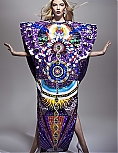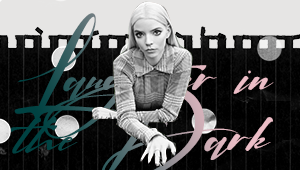 Your first online source for all things ANYA TAYLOR-JOY. She is an American-born Argentine-British actress and model. She is best known for her role as Casey Cooke in "Split" (2017), her lead role as Thomasin in "The Witch" (2015) and more recently in "The Queen's Gambit" (2020) playing Beth Harmon. Enjoy your stay!
Your first online source for all things ANYA TAYLOR-JOY. She is an American-born Argentine-British actress and model. She is best known for her role as Casey Cooke in "Split" (2017), her lead role as Thomasin in "The Witch" (2015) and more recently in "The Queen's Gambit" (2020) playing Beth Harmon. Enjoy your stay!





NEW YORK POST – Some months after shooting had ended on Anya Taylor-Joy’s debut movie, 2015’s acclaimed supernatural horror film “The Witch,” she was called back for two days of reshoots. As the actress slipped into her familiar smock and bonnet, she began to sob. “It was like being reunited with a friend,” she recalls. “I hadn’t yet understood that characters were real for me. When I finished that movie, I just fell into a really big depression, and then I realized it was because I didn’t have [my character] Thomasin around.”
Taylor-Joy, 23, has been going through a similar grieving process for Emma, the famously hotheaded, overly confident titular heroine of Jane Austen’s fourth novel, although a press tour for the movie, opening Feb. 21, has brought some solace. “It’s almost like an assisted grieve,” she says, laughing. “I spent more time being Emma than I did being Anya. It was like living with a twin sister.”
Any sorrow over the separation has also been mitigated by the friendships made on set. “We all fell in love,” she tells Alexa. “At the beginning, I was trying to be pragmatic, and saying, ‘I’m going to really keep myself to myself and be very quiet and read a lot of books,’ but then I was introduced to this cast and that went straight out the window.”
Cloistered for much of the filming just outside the English resort town of Brighton, Taylor-Joy bonded particularly well with her young co-stars Mia Goth (“Suspiria”), Callum Turner (“Fantastic Beasts: The Crimes of Grindelwald”), Josh O’Connor (“The Crown”) and Johnny Flynn (soon-to-be David Bowie in “Stardust”).
“Any time we weren’t in front of the camera together, we were off-camera together,” Taylor-Joy says. “There was never a dinner by yourself — it was dinner with everybody.” She credits first-time director Autumn de Wilde for engineering such a love-fest. “She’s a brilliant friends matchmaker. She does it much better than Emma.”
Ah yes, Emma. As with “Little Women,” every generation must get an “Emma” for its era — sometimes several. Great literature is timeless, but “Emma” has been so frequently immortalized on-screen (including in the famous 1995 Beverly Hills update, “Clueless”) that you may wonder if we need another go-around.
It turns out that we do.
In the hands of de Wilde, until now best known as a photographer, this new Emma is less winsome than others we have known, truer perhaps to Austen’s vision. The writer described her protagonist as someone “no one but myself will much like.” For at least three-quarters of this movie (set in corseted 1800s England, like its source material), Taylor-Joy’s Emma is so comically tone-deaf to the consequences of her actions that you sometimes want to step in and give her a vigorous shake.
And yet, who could not fall, as George Knightley does, for her determination, her vivaciousness, her #TimesUp autonomy?
Taylor-Joy is electric on-screen and manages the tricky feat of showing a young woman in transition, gradually growing into her adult self, by turns vulnerable and defiant. The film caps a remarkable five-year journey for the star, who seems capable of handling any role, period, accent or genre thrown her way.
It helps that she has an uncanny ability to mimic, perhaps because (although she was born in Miami), she grew up in Argentina and only learned English after her family moved to the UK when she was 6 years old. For Thomasin in “The Witch,” Taylor-Joy channeled a pitch-perfect Yorkshire accent by listening to her young co-star Lucas Dawson. For Illyana Rasputin, a Russian killing machine in the upcoming X-Men spin-off “The New Mutants,” she didn’t even use a vocal coach.
“I just listened to a lot of Russian radio, to the different ways that they formed vowels, the heavy Ds and all of that … It’s frightening when you have a skill you can’t explain because you’re always terrified you’re going to wake up one morning and it’s going to leave you.”
Although she does not consider herself a Method actor, she prepares for her roles in other ways, including elaborate Spotify play-lists. For “Emma,” the guiding track was “Rich Girl,” the classic Hall & Oates song about a privileged woman. For her gangster moll Gina Gray in the cult British crime series “Peaky Blinders,” her playlist runs the gamut from Fred Astaire to André 3000.
“Each character that I play, I have a different way of getting into them,” she explains. “For Gina, my morning routine was very important. I would put on my playlist, and take care in sensually dressing myself — the stocking comes on, and then the slips, and then the jewelry, all in a very overdramatic Gina Gray way.”
Ironically, the emotional kinship with her characters, so illuminating on-screen, was the very quality that stood her apart in childhood. At school, which she describes as “miserable,” she was a loner. “I think a lot of people mistakenly believe that it’s cool not to care — especially when you’re 13, 14 — but I just care so much about everything,” she says. “If I like something, I don’t just like it, I love it.”
Her alienation was exacerbated by the culture shock of moving from Argentina to the UK as a young child. “We went from this idyllic, countryside existence where I was surrounded by horses and dogs and ducklings to a very gray city center where I was only allowed a hamster,” she recalls.
Not coincidentally, her favorite book was “Peter Pan,” in which a young girl escapes London to a place where she can belong, wild and free. Taylor-Joy was convinced such a place existed for her, too.
“I knew there was a world where I would not just fit in, but be celebrated for being myself, and not have to make myself less weird or less nerdy, or less emotional in order to fit in.”
Almost all actors have a story about the moment they knew they were destined to act. For Taylor-Joy, the certainty was almost supernatural.
“My mum has a video of me when I’m, like, 8 years old, and she says, ‘What are you going to be when you grow up?’ And I say, ‘I’m going to be an actor.’ And she says, ‘Are you going to go to drama school?’ And with utter conviction, I’m like, ‘No. I’m going to be at the right place at the right time. It’s going to happen for me.’”
The right place and the right time turned out to be London’s ritzy Knightsbridge neighborhood when she was just 16 years old, out walking her dog. Spotted by a passing model scout, she was quickly booked for a shoot. That shoot just happened to take place on the set of “Downton Abbey,” where she just happened to meet Allen Leech (who played fiery Irish chauffeur Tom Branson on the series), who just happened to pass her name to his agent, who called her within the week.
As she predicted, Taylor-Joy never did go to drama school. By the age of 18, after a few television cameos, she was filming her breakout role in “The Witch,” for which Rolling Stone critic Peter Travers hailed her as “a genuine acting find.” In the five years since, she’s worked on nearly two dozen projects. “I’ve grown up on these sets,” she reflects.
But off-screen and out of costume, her sense of identity has often seemed more tenuous. Shortly after receiving the script for “Emma,” she says (with exemplary candor) that she had a “breakdown.”
Confronted with the challenge of leading a cast of so many actors she admired, she panicked. “I was suddenly scared that I was going to let all of them down, and had a bit of a freak-out,” she recalls. “It was a sense of, ‘Oh my goodness, I can tell you what all of my characters like and dislike, but I’m not even sure what I like or dislike anymore.’”
The moment was an epiphany, one that she’s held on to.
“I realized that there are aspects of myself that need some tending,” she says. “Weirdly, the place that I feel most secure and most at home is in my understanding of myself as an artist; but in my understanding of myself as a 23-year-old woman, I need to carve out some time to figure that out, because I don’t really know what that looks like yet.”
Although she begins two new projects in March, she’s determined to find a balance. “I used to be a dancer, and dancing is my form of therapy,” she says. “So I want to throw myself into an intensive dance course with no goal other than to get better at something that I love.”





